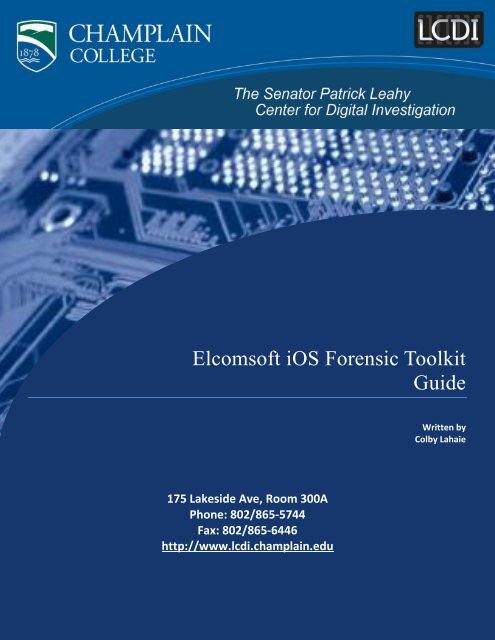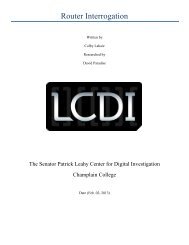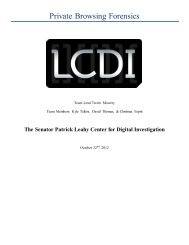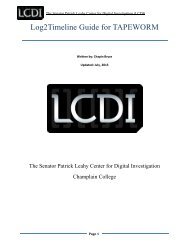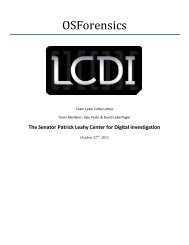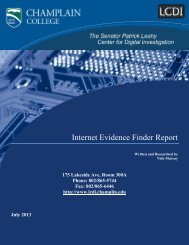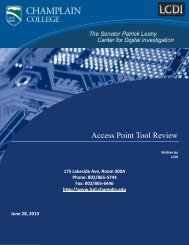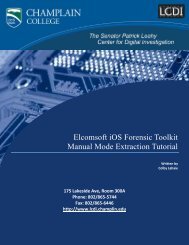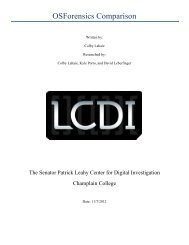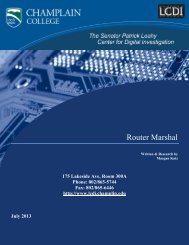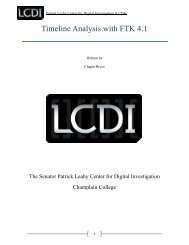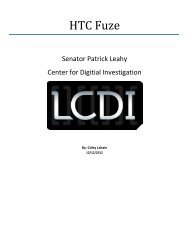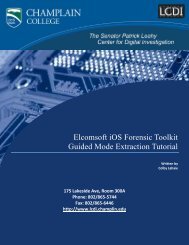Elcomsoft iOS Forensic Toolkit Guide - Computer and Digital Forensics
Elcomsoft iOS Forensic Toolkit Guide - Computer and Digital Forensics
Elcomsoft iOS Forensic Toolkit Guide - Computer and Digital Forensics
You also want an ePaper? Increase the reach of your titles
YUMPU automatically turns print PDFs into web optimized ePapers that Google loves.
Patrick Leahy Center for <strong>Digital</strong> Investigation (LCDI)<strong>Elcomsoft</strong> <strong>iOS</strong> <strong>Forensic</strong> <strong>Toolkit</strong><strong>Guide</strong>Written byColby Lahaie175 Lakeside Ave, Room 300APhone: 802/865-5744Fax: 802/865-6446http://www.lcdi.champlain.eduPage 1 of 20
Patrick Leahy Center for <strong>Digital</strong> Investigation (LCDI)Published DateDisclaimer:This document contains information based on research that has been gathered by employee(s) of The SenatorPatrick Leahy Center for <strong>Digital</strong> Investigation (LCDI). The data contained in this project is submittedvoluntarily <strong>and</strong> is unaudited. Every effort has been made by LCDI to assure the accuracy <strong>and</strong> reliability of thedata contained in this report. However, LCDI nor any of our employees make no representation, warranty orguarantee in connection with this report <strong>and</strong> hereby expressly disclaims any liability or responsibility for lossor damage resulting from use of this data. Information in this report can be downloaded <strong>and</strong> redistributed byany person or persons. Any redistribution must maintain the LCDI logo <strong>and</strong> any references from this reportmust be properly annotated.Table of ContentsIntroduction ............................................................................................................................................................................. 4General Description ................................................................................................................................................................ 4Supported Devices .............................................................................................................................................................. 4Figure 1 - Compatible Devices <strong>and</strong> Platforms ................................................................................................................ 5<strong>Guide</strong>d Mode ...................................................................................................................................................................... 6Figure 2 - Running <strong>Guide</strong>d Mode ................................................................................................................................... 6Figure 3 - <strong>Elcomsoft</strong> <strong>iOS</strong> <strong>Forensic</strong> <strong>Toolkit</strong> Menu .......................................................................................................... 6Manual Mode ...................................................................................................................................................................... 7Figure 4 - Running Manual Mode ................................................................................................................................... 7Logging ............................................................................................................................................................................... 7Figure 5 - Logging File ................................................................................................................................................... 8Acquiring Physical Image(s) of <strong>iOS</strong> Device File system(s) ............................................................................................... 8Figure 6 - Placing the Device into DFU Mode ............................................................................................................... 9Figure 7 - Loading the Ramdisk with <strong>Guide</strong>d Mode .................................................................................................... 10Figure 8 - Loading the Ramdisk with Manual Mode .................................................................................................... 10Figure 9 - <strong>iOS</strong> Comm<strong>and</strong>s to Load Ramdisk ................................................................................................................ 11Figure 10 - Acquiring System Partition with <strong>Guide</strong>d Mode ......................................................................................... 11Figure 11 - Acquiring User Partition with Manual Mode ............................................................................................. 12Figure 12 - User Partition Transfer Times .................................................................................................................... 12Acquiring Logical Partition .............................................................................................................................................. 12Figure 13 - Acquiring Users’ Files as Tarball (Logical Acquisition) ........................................................................... 14Page 2 of 20
Patrick Leahy Center for <strong>Digital</strong> Investigation (LCDI)Recovering User Lock Passcode from <strong>iOS</strong> 4.x/5.x Devices ............................................................................................. 15Figure 14 - Bruteforcing a Simple Passcode ................................................................................................................. 15Figure 15 - Dictionary Attack Against a Complex Passcode ........................................................................................ 16Recovering Encryption Keys <strong>and</strong> Keychain Data ............................................................................................................. 16Figure 16 - Recovering Encryption Keys <strong>and</strong> Keychain Data with <strong>Guide</strong>d Mode ....................................................... 17Figure 17 - Recovering Encryption Keys <strong>and</strong> Keychain Data with Manual Mode ...................................................... 17Decrypting User Partition <strong>and</strong> Keychain Data .................................................................................................................. 17Figure 18 – Decrypting the User Partition with <strong>Guide</strong>d Mode ..................................................................................... 18Figure 19 – Decrypting the Keychain Data with Manual Mode ................................................................................... 18Analyzing the Data ........................................................................................................................................................... 18Figure 20 - Extracted Data ............................................................................................................................................ 19Figure 21 - Analyzing Extracted Data in FTK 4.1 ........................................................................................................ 20Page 3 of 20
Patrick Leahy Center for <strong>Digital</strong> Investigation (LCDI)IntroductionApple products, specifically mobile devices, have become some of the most popular devices around. An article I foundon Engadget states that, as of June 10, 2013, Apple has sold 600 million <strong>iOS</strong> Devices. 1 Since <strong>iOS</strong> devices can do justabout everything, including storing word document files, pictures, text messages, etc., it is very important for investigatorsto be able to acquire data from these devices during an investigation. One tool that allows investigators to easily recoverdata comes from the company <strong>Elcomsoft</strong>. <strong>Elcomsoft</strong> has many different tools, but their primary tool to recover data from<strong>iOS</strong> devices is called “<strong>Elcomsoft</strong> <strong>iOS</strong> <strong>Forensic</strong> <strong>Toolkit</strong>”.General Description“<strong>Elcomsoft</strong> <strong>iOS</strong> <strong>Forensic</strong> <strong>Toolkit</strong> is a set of tools aimed at making the acquisition of <strong>iOS</strong> devices easier. It consists of<strong>Toolkit</strong> Ramdisk <strong>and</strong> a set of tools to load the Ramdisk onto the <strong>iOS</strong> device.” 2 The tool is an all-in-one, complete solutionthat allows full, bit-precise device acquisitions <strong>and</strong> supports all versions of <strong>iOS</strong> from 3 to 6. 3 It comes with two modes:guided <strong>and</strong> manual. <strong>Guide</strong>d mode has a menu-based user interface that automates the process. Manual mode allows theuser to interact with different tools directly using the comm<strong>and</strong>-line interface. 2 <strong>Elcomsoft</strong> also claims that the tool leavesno traces behind, makes no alterations to device’s contents, <strong>and</strong> every step of investigation is logged <strong>and</strong> recorded. 3 Thetool costs $100 for the trial version (15 days) <strong>and</strong> $1,495 for the full version, it <strong>and</strong> is offered for both Mac <strong>and</strong> Windows.For more information, visit: http://www.elcomsoft.com/eift.html.(Note: This guide will be using the Windows version of the <strong>Elcomsoft</strong> <strong>iOS</strong> <strong>Forensic</strong>s <strong>Toolkit</strong>.)Supported DevicesFigure 1 below provides a list of the supported devices, as provided by the <strong>Elcomsoft</strong> website:1 Smith, M. (2013, June 10). Apple has now sold 600 million <strong>iOS</strong> devices. Engadget. Retrieved August 07, 2013, from http://www.engadget.com/2013/06/10/appleios-devices-2013/2 <strong>Elcomsoft</strong>. (2012). <strong>Elcomsoft</strong> <strong>iOS</strong> <strong>Forensic</strong> <strong>Toolkit</strong>. Retrieved June 6, 2013.3 <strong>Elcomsoft</strong> <strong>iOS</strong> <strong>Forensic</strong>s <strong>Toolkit</strong>. (n.d.). Enhanced <strong>Forensic</strong> Access to IPhone/iPad/iPod Devices Running Apple IOS. Retrieved July 11, 2013, fromhttp://www.elcomsoft.com/eift.htmlPage 4 of 20
Patrick Leahy Center for <strong>Digital</strong> Investigation (LCDI)Figure 1 - Compatible Devices <strong>and</strong> Platforms44 <strong>Elcomsoft</strong> <strong>iOS</strong> <strong>Forensic</strong>s <strong>Toolkit</strong>. (n.d.). Enhanced <strong>Forensic</strong> Access to IPhone/iPad/iPod Devices Running Apple IOS. Retrieved July 11, 2013, fromhttp://www.elcomsoft.com/eift.htmlPage 5 of 20
Patrick Leahy Center for <strong>Digital</strong> Investigation (LCDI)<strong>Guide</strong>d ModeWhen you first acquire the toolkit from <strong>Elcomsoft</strong>, you will need to download <strong>and</strong> extract the toolkit from the zippedfolder to your desired location. Once you have done so, you can begin using the guided mode of the toolkit by clicking onthe <strong>Toolkit</strong>.cmd file (Figure 2). This will open a console window <strong>and</strong> present a text-based menu (Figure 3). <strong>Guide</strong>d modeautomates the process of retrieving the data for the investigator, making it much easier to use the tool. <strong>Guide</strong>d modeallows you to acquire the system <strong>and</strong> user data partitions of <strong>iOS</strong> devices. It also allows you to retrieve a logical extractionof an <strong>iOS</strong> device, as well as recovering the device passcode, device keys, <strong>and</strong> the keychain. <strong>Guide</strong>d mode only allows theuser to recover simple device passcodes (4-digit passcodes) from an <strong>iOS</strong> device. To recover complex passcodes(alphanumeric passcodes of any length), an investigator will have to use the manual mode.Figure 2 - Running <strong>Guide</strong>d ModeFigure 3 - <strong>Elcomsoft</strong> <strong>iOS</strong> <strong>Forensic</strong> <strong>Toolkit</strong> MenuPage 6 of 20
Patrick Leahy Center for <strong>Digital</strong> Investigation (LCDI)Manual ModeTo use the manual mode, begin by opening a comm<strong>and</strong> prompt window where the toolkit is located. To easily do this,hold the shift key down <strong>and</strong> right-click on the folder where the toolkit is located. Then click “Open comm<strong>and</strong> windowhere” (Figure 4). The manual mode option of the <strong>Elcomsoft</strong> <strong>iOS</strong> <strong>Forensic</strong> <strong>Toolkit</strong> is more advanced, requiring theinvestigator to use <strong>and</strong> be comfortable with the comm<strong>and</strong>-line tools provided. Manual mode allows for greaterflexibility <strong>and</strong> is the recommended way of retrieving a device acquisition of <strong>iOS</strong> devices. Manual mode allows you toacquire the system <strong>and</strong> user data partitions of <strong>iOS</strong> devices, <strong>and</strong> has the ability to retrieve a logical extraction of an <strong>iOS</strong>device, as well as recovering the device passcode, device keys, the keychain. Manual mode allows the user to recoversimple device passcodes (4-digit passcodes) as well as complex passcodes (alphanumeric passcodes of any length).Figure 4 - Running Manual ModeLoggingWhen you run the guided mode of the toolkit, it will continuously log all related activity in the console onto a text file.Every time the toolkit is started, a new log file is created in the current directory, which contains output of all invokedcomm<strong>and</strong>s (Figure 5). The file name is saved as: YYYYMMDD_hhmmssZ.logPage 7 of 20
Patrick Leahy Center for <strong>Digital</strong> Investigation (LCDI)Figure 5 - Logging FileAcquiring Physical Image(s) of <strong>iOS</strong> Device File system(s)Most <strong>iOS</strong> devices have two partitions (System <strong>and</strong> User), <strong>and</strong> their names differ between<strong>iOS</strong> versions:• <strong>iOS</strong> 4.x: System is disk0s1 <strong>and</strong> User is disk0s2s1.Page 8 of 20
• <strong>iOS</strong> 5.x: System is disk0s1s1 <strong>and</strong> User is disk0s1s2. 2Patrick Leahy Center for <strong>Digital</strong> Investigation (LCDI)To acquire the system partition, the user partition, or both, an investigator can use either guided mode or manual mode.Before you can acquire the physical image(s) of the file system(s), or before acquiring any data, you have to load thetoolkit Ramdisk to the device. In order to do this, you have to load the device in DFU (Device Firmware Update) mode.You can either do this by manually putting the device in DFU mode or, more easily, you can use menu item 1 in theguided mode, complete with on-screen instructions (Figure 6).Figure 6 - Placing the Device into DFU ModeOnce you place the device in DFU mode, you can upload the toolkit Ramdisk <strong>and</strong> begin acquiring the device. In guidedmode, you can load the toolkit Ramdisk in a matter of seconds with a few keys (Figure 7); in manual mode, you will haveto enter in a comm<strong>and</strong> that will take a little longer to load the Ramdisk to the device (Figure 8). This comm<strong>and</strong> willchange depending on the type of <strong>iOS</strong> device you have (Figure 9).Page 9 of 20
Patrick Leahy Center for <strong>Digital</strong> Investigation (LCDI)Figure 7 - Loading the Ramdisk with <strong>Guide</strong>d ModeFigure 8 - Loading the Ramdisk with Manual ModePage 10 of 20
Patrick Leahy Center for <strong>Digital</strong> Investigation (LCDI)Figure 9 - <strong>iOS</strong> Comm<strong>and</strong>s to Load Ramdisk5Once you upload the toolkit Ramdisk, you can acquire the system (Figure 10) <strong>and</strong> user (Figure 11) file system partitions.The system partition will typically take between 5-7 minutes to acquire, <strong>and</strong> the user partition will vary depending onthe device <strong>and</strong> its size (see Figure 12 for more details).Figure 10 - Acquiring System Partition with <strong>Guide</strong>d Mode5 <strong>Elcomsoft</strong>. (2012). <strong>Elcomsoft</strong> <strong>iOS</strong> <strong>Forensic</strong> <strong>Toolkit</strong>. Retrieved June 6, 2013.Page 11 of 20
Patrick Leahy Center for <strong>Digital</strong> Investigation (LCDI)Figure 11 - Acquiring User Partition with Manual ModeFigure 12 - User Partition Transfer Times5Acquiring Logical PartitionBoth modes of the <strong>Elcomsoft</strong> <strong>iOS</strong> <strong>Forensic</strong> <strong>Toolkit</strong> can acquire a logical partition of supported <strong>iOS</strong> devices as a tarball, atype of Linux archive file (see Figure 13).During logical acquisition, only actual files, [meaning files that aren’t deleted,] are copied to thecomputer (retaining the directory structure). The process is generally significantly faster than physicalacquisition, as the data residing in unallocated areas of the partition does not have to be transferred.Page 12 of 20
Patrick Leahy Center for <strong>Digital</strong> Investigation (LCDI)Logical acquisition currently cannot access files with protection classes requiring encryption based on auser-supplied passcode. Such files are not included in logical image. 5Page 13 of 20
Figure 13 - Acquiring Users’ Files as Tarball (Logical Acquisition)Patrick Leahy Center for <strong>Digital</strong> Investigation (LCDI)Page 14 of 20
Patrick Leahy Center for <strong>Digital</strong> Investigation (LCDI)Recovering User Lock Passcode from <strong>iOS</strong> 4.x/5.x Devices<strong>Elcomsoft</strong> <strong>iOS</strong> <strong>Forensic</strong> <strong>Toolkit</strong> has the ability to recover lock screen passcodes. “Knowing the original passcode is neverrequired, but may come h<strong>and</strong>y in the case of <strong>iOS</strong> 4/5/6 devices. The following chart helps to underst<strong>and</strong> whether you’llneed a passcode for a successful acquisition:• <strong>iOS</strong> 1.x-3.x: passcode not required. All information will be accessible. The original passcode will beinstantly recovered <strong>and</strong> displayed.• <strong>iOS</strong> 4.0-6.x: certain information is protected with passcode-dependent keys, including the following:o Email messageso Keychains (stored login/password information)o Certain third-party application data, if the application requested strong encryption.” 6The guided mode can be used to recover simple passcodes (4-digit passcodes), while the manual mode can be used torecover simple passcodes, passcodes consisting of only digits with a length not equal to 4, <strong>and</strong> complex passcodes(alphanumeric passcodes of any length). “<strong>Elcomsoft</strong> <strong>iOS</strong> <strong>Forensic</strong> <strong>Toolkit</strong> can brute-force <strong>iOS</strong> 4/5/6 simple 4-digitpasscodes in 10-40 minutes (Figure 14). Complex passcodes can be recovered by using a dictionary attack (Figure 15),but requires more time.” 6 You can create your own dictionary list with words you have been provided with, or you c<strong>and</strong>ownload some commonly used dictionary lists off of the Internet.Figure 14 - Bruteforcing a Simple Passcode6 <strong>Elcomsoft</strong> <strong>iOS</strong> <strong>Forensic</strong>s <strong>Toolkit</strong>. (n.d.). Enhanced <strong>Forensic</strong> Access to IPhone/iPad/iPod Devices Running Apple IOS. Retrieved July 11, 2013, fromhttp://www.elcomsoft.com/eift.htmlPage 15 of 20
Patrick Leahy Center for <strong>Digital</strong> Investigation (LCDI)Figure 15 - Dictionary Attack Against a Complex PasscodeRecovering Encryption Keys <strong>and</strong> Keychain Data<strong>Elcomsoft</strong> <strong>iOS</strong> <strong>Forensic</strong> <strong>Toolkit</strong> can access <strong>iOS</strong> secrets, including most keychain data, 7 opening investigators’ access tohighly sensitive data such as login/password information to Web sites <strong>and</strong> other resources.“Unlike previously employed methods relying on lengthy dictionary attacks or brute force passwordrecovery, the new toolkit can extract most encryption keys out of the physical device. With encryptionkeys h<strong>and</strong>ily available, access to most information is provided in real-time. A typical acquisition of aniPhone device takes from 20 to 40 minutes (depending on model <strong>and</strong> memory size); more time is requiredto process 64-Gb versions of Apple iPad. The list of exceptions is short, <strong>and</strong> includes user’s passcode,which can be brute-forced or recovered with a dictionary attack.” 6Before extracting the encryption keys <strong>and</strong> keychain data, you must first obtain the passcode to be able to unlock the phone.Extracting the encryption keys is important as they are required to decrypt files stored on the user partition <strong>and</strong> contents ofthe keychain. An investigator can use both the guided mode (Figure 16) <strong>and</strong> the manual mode (Figure 17) to recover theencryption keys <strong>and</strong> keychain data.7 The keychain is the password management system on Apple devices. It allows a user to store passwords for programs, e-mail accounts, web sites, <strong>and</strong> more.Page 16 of 20
Figure 16 - Recovering Encryption Keys <strong>and</strong> Keychain Data with <strong>Guide</strong>d ModePatrick Leahy Center for <strong>Digital</strong> Investigation (LCDI)Figure 17 - Recovering Encryption Keys <strong>and</strong> Keychain Data with Manual ModeDecrypting User Partition <strong>and</strong> Keychain DataOnce you have recovered the keychain data, the user lock passcode, <strong>and</strong> acquired the user partition, an investigator canbegin decrypting the data. By decrypting this data, all of the information will become readable <strong>and</strong> accessible to anPage 17 of 20
Patrick Leahy Center for <strong>Digital</strong> Investigation (LCDI)investigator. Once again, you can use both the guided mode (Figure 18) <strong>and</strong> the manual mode (Figure 19) to decryptthe user partition <strong>and</strong> the keychain data.Figure 18 – Decrypting the User Partition with <strong>Guide</strong>d ModeFigure 19 – Decrypting the Keychain Data with Manual ModeAnalyzing the DataOnce you have successfully extracted <strong>and</strong> decrypted all of the data (Figure 20), you can begin analyzing it with forensicacquisition <strong>and</strong> analysis tools, such as FTK Imager <strong>and</strong> FTK (<strong>Forensic</strong> <strong>Toolkit</strong>) 4.1 (Figure 21). Our research claimed thatyou can read this type of file (.dmg file format) in EnCase, but we were unable to open the image files.Page 18 of 20
Patrick Leahy Center for <strong>Digital</strong> Investigation (LCDI)Figure 20 - Extracted DataPage 19 of 20
Patrick Leahy Center for <strong>Digital</strong> Investigation (LCDI)Figure 21 - Analyzing Extracted Data in FTK 4.1Page 20 of 20


